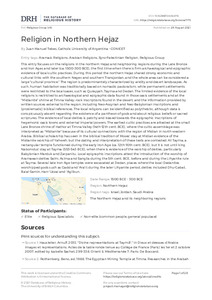Por favor, use este identificador para citar o enlazar este ítem:
https://repositorio.uca.edu.ar/handle/123456789/13218| Campo DC | Valor | Lengua/Idioma |
|---|---|---|
| dc.contributor.author | Tebes, Juan Manuel | es |
| dc.date.accessioned | 2021-12-16T18:35:55Z | - |
| dc.date.available | 2021-12-16T18:35:55Z | - |
| dc.date.issued | 2021 | - |
| dc.identifier.citation | Tebes, J.M. Religion in Northern Hejaz [en línea]. Database of Religious History. 2021 doi:10.14288/1.0404476 Disponible en: https://repositorio.uca.edu.ar/handle/123456789/13218 | es |
| dc.identifier.uri | https://repositorio.uca.edu.ar/handle/123456789/13218 | - |
| dc.description.abstract | Abstract: This entry focuses on the religions in the northern Hejaz and neighboring regions during the Late Bronze and Iron Ages and later (ca. 1500-300 BCE), the first time when there is firm archaeological and epigraphic evidence of local cultic practices. During this period the northern Hejaz shared strong economic and cultural links with the southern Negev and southern Transjordan, and the whole area can be considered a large "cultural province." The region is predominantely characterized by aridity and desert landscapes. As such, human habitation was traditionally based on nomadic pastoralism, while permanent settlements were restricted to the local oases, such as Qurayyah, Tayma and Dedan. The limited evidence of the local religions is restricted to archaeological and epigraphic data found in those oasis settlements and at the "Midianite" shrine at Timna Valley; rock inscriptions found in the desert; and the information provided by written sources external to the region, including Neo-Assyrian and Neo-Babylonian inscriptions and (problematic) biblical references. The local religions can be identified as polytheistic, although data is conspicuously absent regarding the existence of a pantheon of gods and about religious beliefs or sacred scriptures. The evidence of local deities is patchy and biased towards the epigraphic inscriptions of hegemonic oasis towns and external imperial powers. The earliest cultic practices are attested at the small Late Bronze shrine of Hathor at Timna Valley (14th-12th cent. BCE), where the cultic assemblage was interpreted as "Midianite" because of its cultural connections with the region of Midian in north-western Arabia. Biblical scholarship has seen in the biblical tradition of Moses' stay at Midian evidence of the Midianite worship of Yahweh, but the dating and interpretation of these texts are contested. At Tayma, a rectangular temple functioned during the early Iron Age (ca. 12th-10th cent. BCE), but it is not until king Nabonidus' stay at Tayma (553-543 BCE), when there is evidence of the worship of deities, particularly Babylonian Marduk and Zarpanitu. Local epigraphic inscriptions attest the introduction of the worship of Aramaean deities Salm, Asima and Sangila during the 5th cent. BCE, before and during the Lihyanite rule at Tayma. Several late Iron Age temples were excavated at Dedan, places where the local Dedanites worshipped gods such as Gadd and 'Ara'il; during the later Lihyanite period, deities included Dhu-Gabat, Ba'al-šamin, Han-'Uzzai and 'Aglibun. | es |
| dc.format | application/pdf | es |
| dc.language.iso | eng | es |
| dc.publisher | University of British Columbia | es |
| dc.rights | Acceso abierto | * |
| dc.rights.uri | http://creativecommons.org/licenses/by-nc-sa/4.0/ | * |
| dc.source | Database of Religious History. 2021 | es |
| dc.subject | RELIGION | es |
| dc.subject | EDAD DE BRONCE | es |
| dc.subject | EDAD DE HIERRO | es |
| dc.subject | Hejaz | es |
| dc.title | Religion in Northern Hejaz | es |
| dc.type | Artículo | es |
| dc.identifier.doi | 10.14288/1.0404476 | - |
| uca.disciplina | HISTORIA | es |
| uca.issnrd | 1 | es |
| uca.affiliation | Fil: Tebes, Juan Manuel. Pontificia Universidad Católica Argentina. Facultad de Ciencias Sociales; Argentina | es |
| uca.affiliation | Fil: Tebes, Juan Manuel. Consejo Nacional de Investigaciones Científicas y Técnicas; Argentina | es |
| uca.version | publishedVersion | es |
| item.grantfulltext | open | - |
| item.languageiso639-1 | en | - |
| item.fulltext | With Fulltext | - |
| crisitem.author.dept | Facultad de Ciencias Sociales | - |
| crisitem.author.dept | Instituto de Investigaciones de la Facultad de Ciencias Sociales (IICS) | - |
| crisitem.author.dept | Consejo Nacional de Investigaciones Científicas y Técnicas | - |
| crisitem.author.dept | Centro de Estudios de Historia del Antiguo Oriente (CEHAO) | - |
| crisitem.author.dept | Programa de Estudios de las Sociedades Premodernas (PESPREM) | - |
| crisitem.author.orcid | 0000-0002-9623-3380 | - |
| crisitem.author.parentorg | Pontificia Universidad Católica Argentina | - |
| crisitem.author.parentorg | Facultad de Ciencias Sociales | - |
| crisitem.author.parentorg | Departamento de Historia | - |
| crisitem.author.parentorg | Instituto de Investigaciones de la Facultad de Ciencias Sociales (IICS) | - |
| Aparece en las colecciones: | Artículos | |
Ficheros en este ítem:
| Fichero | Descripción | Tamaño | Formato | |
|---|---|---|---|---|
| religion-northern-hejaz.pdf | 469,18 kB | Adobe PDF |  Visualizar/Abrir |
Visualizaciones de página(s)
44
comprobado en 27-abr-2024
Descarga(s)
579
comprobado en 27-abr-2024
Google ScholarTM
Ver en Google Scholar
Altmetric
Altmetric
Este ítem está sujeto a una Licencia Creative Commons

